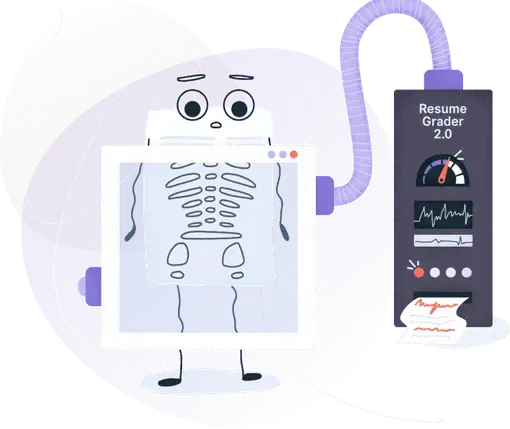Robotics Skills: Example Usage on Resumes, Skill Set & Top Keywords in 2025
Including robotics expertise on your resume signifies to recruiters your aptitude for innovation and problem-solving abilities. Dive into the guide below to infuse your resume with inspiration and discover alternate skill phrasings.


Is your resume ATS-friendly?
Drop your resume here or upload a file to find out if the skills in your resume are readable by an ATS.
Robotics skill refers to the knowledge and abilities required to design, build, program, and operate robots. These skills can be very attractive to employers as they demonstrate a candidate's proficiency with complex systems, problem-solving capabilities, and technical knowledge. Expertise in robotics can set a resume apart, signaling to potential employers a readiness to engage with high-tech tasks and an aptitude for innovative solutions in automation, manufacturing, or even artificial intelligence-related fields.
However, emphasizing robotics skills on a resume might narrow your job prospects, as it could pigeonhole you into a specific niche. Some employers may assume you're only interested in roles that involve robots, which could limit your opportunities in broader engineering or technology positions. To create a more balanced resume, consider combining your robotics skills with a range of other technical and soft skills. This shows versatility and an ability to contribute to various aspects of a business. Saying that you're adaptable and a quick learner could make you more attractive to a wider array of employers.
In this article, you will learn:
- The advantages of having robotics skills on your resume and how they can make you stand out to employers.
- The potential limitations of overemphasizing robotics skills and strategies to maintain a well-rounded professional profile.
- Good and bad examples of how to list robotics skills, including synonyms and alternative phrases to describe your expertise.
Misusage of robotics on resumes
Including robotic skills on a resume can significantly increase your appeal to potential employers in relevant industries, but improper depiction of these abilities can undermine credibility. Overstating your expertise or including irrelevant robotics experience can lead to awkward situations in interviews or on the job, where you may not meet expectations based on your resume claims. It's crucial to present your skills honestly and clearly to align with the requirements of the position you're applying for.
- In the summary section: Claiming to be an "expert robot operator with extensive experience in AI-driven systems" when you've only used a simple programmable robot arm in a classroom setting.
- In the experience section: Writing "Led a team in deploying advanced robotics for manufacturing automation," when your role was limited to observing the process as an intern.
- In the achievements section: Listing "Pioneered a robotic program that increased company productivity by 50%" without context or proof, especially if the initiative was not directly related to your actions.
How to demonstrate robotics skills on your resume
- List relevant coursework or projects that involved robotics, showcasing your hands-on experience and success in applying theoretical knowledge to real-world applications.
- Highlight programming languages you’re proficient in, such as Python or C++, and any specific robotics frameworks or tools you have used, like ROS or OpenCV.
- Detail your experience with different types of sensors and actuators, and how you have used them to build or control robotic systems effectively.
- Include any internships or work experience in robotics, detailing your role, responsibilities, and any contributions that led to improvements or innovations.
- Quantify your achievements when possible, such as percentages of efficiency gains, money saved through automation, or the number of tasks automated using robotic solutions.
Example 1: Demonstrate robotics in the experience section
- •Led the design of a path planning system for Atlas, improving movement efficiency by 20%.
- •Collaborated in multidisciplinary teams to integrate sensors and actuators, increasing robot responsiveness.
- •Pioneered a machine learning approach to reduce operational errors, resulting in a 15% boost in reliability.
- •Spearheaded the automation of the Roomba vacuum cleaning patterns, enhancing coverage by 25%.
- •Managed the robot testing phase, achieving a 10% decrease in customer-reported issues.
- •Authored technical documentation to streamline the production process, aiding a 15% faster assembly time.
- •Implemented a predictive maintenance program that reduced downtime by 30%.
- •Participated in the upgrade of robot controllers, shortening the production cycle by 8%.
- •Trained 20+ new technicians, improving team performance and operational standards.
- Show specific results of your work, like increased efficiency or decreased errors
- Talk about collaboration and how you improved the team or product through teamwork
- Discuss innovative solutions or approaches you developed and the positive outcomes that followed
- Quantify your achievements to provide a clear understanding of your impact
- Ensure each bullet point covers a different aspect of your job to show a range of skills and contributions
- Describe significant projects and how they were aligned with business goals
- Detail your roles through a narrative that demonstrates your progression and learning
- Avoid repetitive phrases and make every sentence full of information, using simple language for accessibility
- Make the case for why your experience benefits future employers
Example 2: Demonstrate robotics in the summary section
- Demonstrates clear and significant experience (over 10 years) in the field of robotics.
- Highlights both expertise in mechanical design and proficiency in software programming.
- Focuses on a major professional milestone (leading a team to an international championship win), evidencing leadership and team-building skills.
- Expresses genuine enthusiasm for technological advancement, indicating alignment with industry goals.
- Underlines a commitment to ongoing education, suggesting a candidate who values growth and staying current with industry developments.
These elements combine to create a powerful summary that showcases the candidate's qualifications and excitement for their work without relying on overused jargon.
Example 3: Demonstrate robotics in the achievements section
- This resume section clearly shows the applicant's success with concrete numbers and outcomes.
- The use of action verbs like "directed," "crafted," and "implemented" effectively demonstrates initiative and skill without resorting to clichés.
- Each description is concise and focuses on deliverables, avoiding unnecessary filler words.
- The applicant's experience is made tangible by mentioning specific situations and results, reflecting competent use of robotics.
- Describing actual work environments like regional competitions, warehouses, and production lines gives a realistic frame of reference for the applicant's capabilities.
- Brevity in the achievement titles makes them easily digestible and emphasizes key accomplishments.
What are the relevant certifications for robotics skills on resume
If you are looking to demonstrate your proficiency in robotics, there are a variety of certifications you might consider adding to your resume.
The top 5 certifications for gaining robotics skills expertise:
This certification validates your skills in the design, operation, and maintenance of robots, equipping you with recognition in the engineering aspects of robotics.
Focused on the software side, RPAC confirms your expertise in automating tasks using robotics software, which is crucial for efficiency in various industries.
By obtaining the RTC, you show that you've received practical training in robotics systems and are prepared to support and work with robotic technologies in a hands-on environment.
The PRD certification is ideal if you specialize in developing and programming robotic systems, proving that you have advanced competencies to potential employers or clients.
This diploma goes beyond basic principles, offering a deep dive into advanced robotics and automation, preparing you for leadership roles and innovative robotics projects.
Top skills people add together with robotics skill on resume:
Programmable Logic Controllers (PLCs)
Automation
Electrical Engineering
Computer Vision
Artificial Intelligence
Machine Learning
Control Systems
Mechatronics
Embedded Systems
CAD Design
Problem Solving
Creativity
Teamwork
Attention to Detail
Adaptability
Communication
Project Management
Critical Thinking
Time Management
Leadership
Continuous Learning
Most relevant jobs for robotics skills
If you’re passionate about robotics, there are numerous careers where such expertise is crucial. Robotics combines areas of engineering, computer science, and technology, driving advances in various industries. Whether contributing to manufacturing automation, enhancing medical procedures or extending our capabilities in space, those with a robotic skill set find themselves in high demand. From developing new robots to maintaining and operating existing systems, the applications of robotics are vast and varied.
- Robotics engineer
- Software developer: Robotics systems
- Control systems engineer
- Robotics technician
- Automation engineer
- Robotics test engineer
- Mechanical designer: Robotics
- Artificial intelligence engineer
- Electrical engineer: Robotics
- Research scientist: Robotics
Key takeaways
- Adding robotics skills to your resume shows potential employers your ability to work with automated systems and advanced technologies.
- Improper use of robotics skills can lead to inefficiencies; avoid them by staying updated with industry best practices.
- Showcase your robotics expertise on your resume by citing relevant projects, certifications, and practical experiences.
Make one that's truly you.




